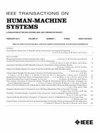A Novel Measure of Human Safety Perception in Response to Flight Characteristics of Collocated UAVs in Virtual Reality
IF 4.4
3区 计算机科学
Q2 COMPUTER SCIENCE, ARTIFICIAL INTELLIGENCE
引用次数: 0
Abstract
This article examines how people respond to the presence of a flying robot under various operating conditions using traditional human physiological measures and a novel head movement measurement. A central issue to the integration of flying robotic systems into human-populated environments is how to improve the level of comfort and safety for people around them. Traditional motion control algorithms in robotics tend to focus on the actual safety of collision avoidance. However, people's perceived safety is not necessarily equivalent to the actual safety of the vehicle. Therefore flight control systems must account for people's perception of safety beyond the actual safety of the aerial vehicles in order to allow for successful interaction between humans and the unmanned aerial vehicles (UAVs). Across three experiments participants passively observed quadrotor trajectories in a simulated virtual reality environment. Quadrotor flight characteristics were manipulated in terms of speed, altitude, and audibility to examine their effect on physiological arousal and head motion kinematics. Physiological arousal was greater when the quadrotor was flying with the audio on than off, and at eye-height than overhead, and decreased over repeated exposure. In addition, head acceleration away from the UAVs indicating defensive behavior was stronger for faster speed and audible UAVs. These data suggest head acceleration can serve as a new index specific for measuring perceived safety. Applications intended for human comfort need to consider constraints from specific measures of perceived safety in addition to traditional measures of general physiological arousal.针对虚拟现实中同位无人机飞行特性的人类安全感知新测量方法
本文利用传统的人体生理测量方法和一种新型头部运动测量方法,研究了在各种操作条件下,人们对飞行机器人的存在有何反应。将飞行机器人系统集成到人类居住的环境中的一个核心问题是如何提高周围人员的舒适度和安全性。传统的机器人运动控制算法往往侧重于避免碰撞的实际安全性。然而,人们感知到的安全性并不一定等同于车辆的实际安全性。因此,飞行控制系统必须考虑到人们对安全性的感知,而不是飞行器的实际安全性,这样才能实现人与无人驾驶飞行器(UAV)之间的成功互动。在三项实验中,参与者在模拟虚拟现实环境中被动地观察四旋翼飞行器的飞行轨迹。四旋翼飞行器的飞行特性在速度、高度和可听度方面都受到了控制,以检查它们对生理唤醒和头部运动运动学的影响。当四旋翼飞行器打开音频时,生理唤醒程度大于关闭音频时,处于视线高度时,生理唤醒程度大于处于头顶高度时,并且随着反复接触而降低。此外,当无人机速度较快且发出声音时,头部加速远离无人机,表明防御行为更强。这些数据表明,头部加速度可以作为衡量感知安全性的新指标。除了传统的一般生理唤醒测量方法外,以人类舒适度为目的的应用还需要考虑特定安全感测量方法的制约因素。
本文章由计算机程序翻译,如有差异,请以英文原文为准。
求助全文
约1分钟内获得全文
求助全文
来源期刊

IEEE Transactions on Human-Machine Systems
COMPUTER SCIENCE, ARTIFICIAL INTELLIGENCE-COMPUTER SCIENCE, CYBERNETICS
CiteScore
7.10
自引率
11.10%
发文量
136
期刊介绍:
The scope of the IEEE Transactions on Human-Machine Systems includes the fields of human machine systems. It covers human systems and human organizational interactions including cognitive ergonomics, system test and evaluation, and human information processing concerns in systems and organizations.
 求助内容:
求助内容: 应助结果提醒方式:
应助结果提醒方式:


